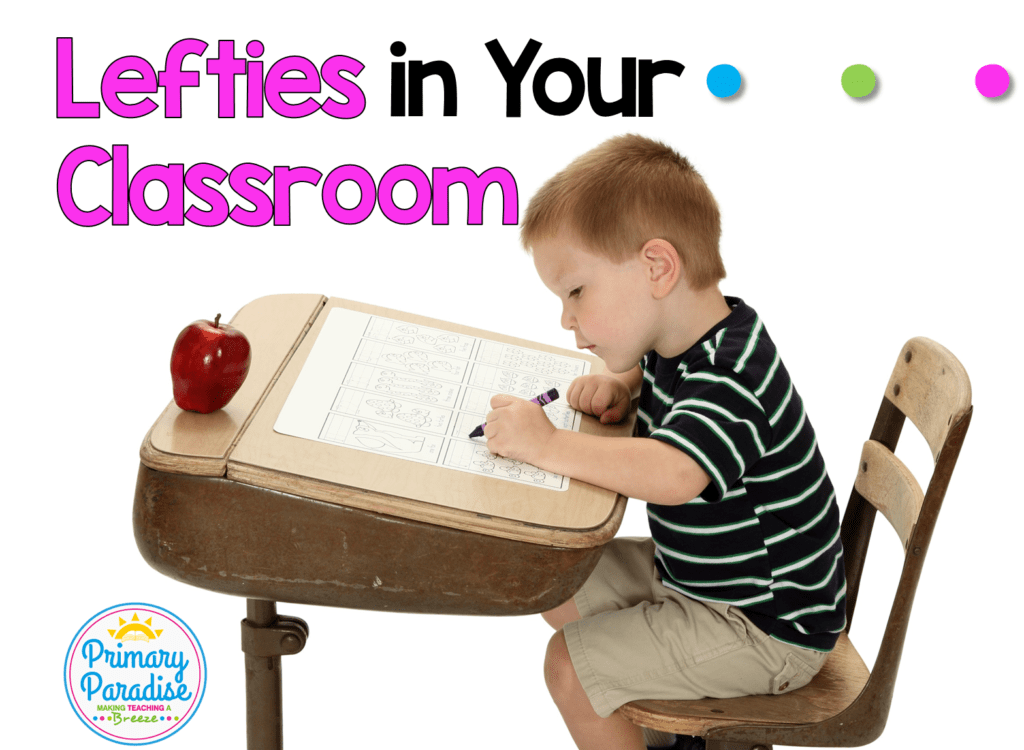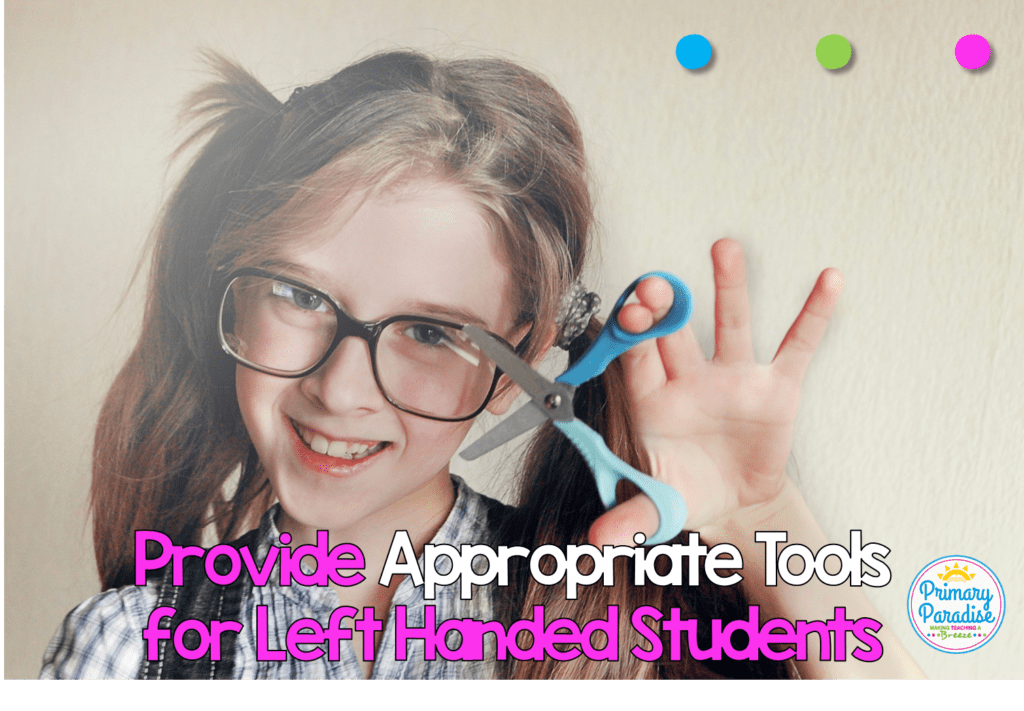Although only about 10% of the world’s population is left handed, you’re bound to end up with lefties in your class. If you’re a right handed teacher, like 90% of the world’s population, this might not be a topic that’s ever even occurred to you as something to be aware of in your classroom. As a lefty myself, I feel this is an important topic. Today I’m going to share with you some of the struggles of being a left handed student.I’ll also share some practical and helpful advice to help you better support the lefties in your class.
Watch my Facebook live on this topic here.

This post contains affiliate links.
Why Lefties? My Personal Experience
Again, as a a right handed person, you might wonder why this topic even needs to be addressed. Personally, this is a very important issue to me. I went to elementary and middle school in the 90’s, and while the teacher was no longer slapping my left hand with a ruler and forcing my pencil into my right hand, I have very vivid memories of embarrassing experiences related to my handedness.
I had many teachers who simply didn’t understand my struggles, or didn’t seem to care. I had teachers who didn’t know how to properly teach me how to hold a pencil. There were teachers without left handed scissors. I had teachers who taught me cursive but didn’t show me how to tilt my paper correctly so my cursive didn’t look at all like my peers. Finally, I had a teacher in middle school who, after I asked for a very small modification because I was struggling, not only refused, but publicly shamed me in front of the class.
Is it Really that Big of a Deal?
I am not trying to be melodramatic, but these are real experiences I had. I also had teachers who encouraged me as my (terrible) handwriting slightly improved, tried their best to accommodate my needs, and gave me seating so I wasn’t bumping elbows with classmates. So, while I’m a happy, functioning adult now, I do believe that, as teachers, it’s our responsibility to meet the needs of all of our students.
I don’t in any way want to sound as if I think left handedness is a disability. It’s not. In fact, it can be a huge benefit in life. However, in a classroom setting, it is something that can make life difficult, especially in the years when being different can be hard enough as it is. As teacher’s is it our responsibility to try our best to remove obstacles for our students that hinder learning. This allows us to create a sense of comfort and confidence in the classroom.
So, please read on to learn 5 simple, practical ways you can support your left handed students.

1. Be Aware
The first way to support your left handed students is to identify them. At the beginning of the year, or even right now, take a quick inventory of which students are writing with their left hand. Please, do NOT make them all stand up. You don’t want to make students feel put on the spot. Simply observe which hand they write and cut with. Also, know that handedness isn’t all or nothing, so students might use their left hand for some things and right hand for others.
Once you’ve identified students who are left handed, you can pull them aside and see if there are any accommodations that would be helpful for them. If your students are younger or less mature, I’d also watch for tasks that you see them struggling with, and then use the next to steps to meet their needs.
2. Be Educated About Options
It’s amazing how many options there are for left handed people these days.Thanks to Amazon, they are now widely available. I don’t think you need to run out and purchase all of these items, but it is definitely helpful to have resources available for parents with questions. I do think every classroom needs a few good sets of left handed scissors.
From left handed pens, scissors, and pencil grips to left handed notebooks, there are so many options available. Here are a few of my favorites, but as you’ll see in number 3, most accommodations for your lefties are free and very simple.
3. Be Accommodating
Accommodating for your left handed students doesn’t have to be complicated or break the bank. The key is to be open and accepting. If you’re a right handed person, the challenges left handed students face are probably not apparent to you. It really is a right handed world. From how books are bound to pretty much every tool students use, lefties are at a disadvantage. Thankfully, children are very adaptable, but there are some things you can do to make learning easier.

Scissors
This is one you’re most likely aware of already, but cutting was anxiety inducing for me as a child. Back in the day, left handed scissors were awful. Imagine trying to cut with two very, very dull butter knives. And that was if I was lucky enough to be in a class with left handed scissors at all. Cutting with right handed scissors with your left hand? Pretty much the same experience. Honestly, it was often mortifying how much I struggled with cutting. Often times, my teachers would just cut for me or make another student cut for me, which added to the embarrassment.
So, here are some suggestions:
-Make sure you have good left handed scissors for your students. And, if possible, have more than one pair in case you have more than 1 south paw.
-Don’t force them to use left handed scissors. Many lefties prefer to use right handed scissors upside down with their left hand or simply cut with their right hand. Ask them what their preference is. If they don’t have one, allow them to try different options and figure out what works. Even if it looks weird and uncomfortable, if they’re okay with it and it’s working, let them do what works for them.
Pens, Pencils, & Markers, Oh My
Since we write from left to right in our society, that can make writing tricky for left handed students. As a lefty, one typically has to drag their hand over their freshly written words, which can cause smearing and a lovely ink or pencil stain on the hand. Be willing to make accommodations when it comes to writing instruments. Obviously pens might not be an option in lower elementary, but allowing students to use crayons (which are less likely to smear) instead of markers if they wish, or a mechanical pencil instead of a traditional pencil, can really help.
A good pencil grip can also help with this problem, but may not be comfortable or helpful for every student. And for those times when smearing is inevitable, keep baby wipes or wet ones in your desk so your lefties can clean off their hand after writing or drawing.
Make Note of the Binder & Notebook Bind

In preparation for this article, I polled many left handed people about things that were difficult for them in school. Hands down (pun totally intended), the biggest complaints were related to 3 ring binders and spiral bound notebooks. As a left handed student, it’s very difficult, and can actually be painful, to write in both spiral bound notebooks and binders.
When I was in middle school, I had a teacher who required us to take notes in a 3 ring binder. After class, I asked if I could take my paper out to write during class and then put it back in the binder because it was really uncomfortable to write in (and he had told the class that he required the paper to stay in the binder at all times.) He told me no. He told me I’d lose my papers. I remember crying hot, angry tears, but I never told my mom, so nothing ever changed. Looking back, that was so ridiculous. He had a student requesting an accommodation for a very real reason, and he flat out said no.
-The solution for binders and spiral notebooks is actually very simple. Allow left handed students to take papers out of the binder to write. That’s it. Easy, peasy.
For spiral notebooks, you can purchase left handed notebooks, but that’s really not necessary. Simply allow students to use the notebook backwards (Does it really matter if the holes are on the left?) Or give them a composition book instead, which completely eliminates the problem.
Handwriting Issues

It’s a well known “fact” that left handed people struggle with having sloppy handwriting. This is simply just not true. I know many left handed people (myself not included) who have beautiful handwriting. However, I do think many left handed students struggle with handwriting simply because it’s a right handed world. When I learned to write in kindergarten, I don’t remember my teacher showing me how to do anything differently than my right handed counterparts. The thing is, left handed people don’t typically hold the pencil the same way, or form their letters the same way, or at least it doesn’t come naturally. So, when a lefty is trying to copy a right handed teacher, it can result in sloppy writing. (Throw in cursive, and the task is even trickier.) To understand what this is like, think about a Pinterest tutorial for how to do something a new way, like tying shoes or folding a fitted sheet. How awkward is it to try some of those things? That’s a taste of what it’s like to be a south paw trying to write like a north paw.
-If there are any left handed adults in your school, and you have a lefty struggling, have that adult give them some pointers. If you have an OT, they might have some advice as well.
-Of course we need our students to write legibly, but try not to compare students’ writing to each other. As a child, I was reprimanded often for my handwriting. It was soul crushing when I had truly, truly taken my time and done MY best, and the teacher threw my work in the trash and told me to do it again. Additionally, in the digital age we live in, handwriting is less important than in the past.
-As I state, legible handwriting is important, but not everyone is going to be a calligrapher, and that’s okay.
Seating & More
When polling lefties for this post, I heard some bizarre stories about teachers forcing left handed students to always work together, not being able to participate in activities in gym class because they didn’t have the equipment needed (or in my case,we didn’t have left handed mitts, so I’d catch with my left, take off my mitt, and then throw with my left hand- which by that point, everyone had already run home), or not being aware and having a lefty and a righty seated so they constantly bumped elbows.
I think a lot of those cases are extreme, but it’s important to be ensure that all of your students have the supplies and equipment they need to participate fully in class activities.
4. Be Encouraging
In that same poll, I heard so many stories of teachers going above and beyond to ensure that their left handed students were accommodated for and celebrated. Once school had a lefty mentor program where older left handed students paired up with younger lefties. They would help each other out, and even had a lefty party at the end of the year.
Left handed students might struggle in some areas, but they also have so many strengths. They’re often your most creative and artistically inclined students, and 20% of all MENSA members are reported to be left handed.
5. Be Kind
Of course, in all things related to out students, we’re always called to be kind. It’s important to be aware that, just like any students who feel different, left handed students might be sensitive about it, some might be proud, and some might be a mixture of both. Some students might need a lot of accommodations, and some might completely adapt on their own and be fine.
Follow their lead, and support them anyway you can because, at the end of the day, we all want all of our students to grow and succeed!
Are you a lefty? I’d love to hear your experiences! Comment below and share your thoughts.
Join the discussion! Watch my Facebook LIVE video on this topic here.
If you enjoyed this post, make sure to like, comment, and share!
You can join my FREE Facebook Club for k-2 teachers here!
AND BE SURE TO SIGN UP FOR MY NEWSLETTER FOR MORE TIPS, TRICKS, IDEAS AND FREEBIES!





